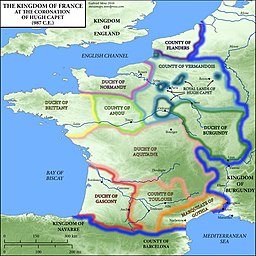Birth of Capetian dynasty
The history of France between 987 AD and 1179
The Capetian dynasty, also known as the House of France was founded by Hugh Capet. It is among the largest and oldest royal houses in Europe and the world and ruled the Kingdom of France from 987 to 1328. The dynasty had a crucial role in the formation of the French state. Hugh Capet’s rule was limited to his own domain around Paris, while the rest of the French kingdom was in the hands of powerful local lords. His direct successors gradually increased the territory over which they had control through conquest and inheritance and also by skillfully exploiting their rights as suzerains in areas not under their direct authority. Under the Capetians, many of the basic administrative institutions of the French monarchy, including Parlements (royal law courts), the States General (representative assembly), and the baillis (royal local officials), began to develop.
The history of medieval France starts with the election of Hugh Capet (940–996) by an assembly summoned in Reims in 987. He was recorded to be recognised king by the Gauls, Bretons, Danes, Aquitanians, Goths, Spanish and Gascons. The new dynasty was in immediate control of little beyond the middle Seine and adjacent territories, while powerful territorial lords such as the 10th- and 11th-century counts of Blois accumulated large domains of their own through marriage and through private arrangements with lesser nobles for protection and support.
Under King Philip I, the kingdom enjoyed a modest recovery during his extraordinarily long reign (1060–1108). His reign also saw the launch of the First Crusade to regain the Holy Land, which heavily involved his family although he personally did not support the expedition. An important part of the French aristocracy also involved itself in the crusades, and French knights founded and ruled the Crusader states. An example of the legacy left in the Middle East by these nobles is the Krak des Chevaliers' enlargement by the Counts of Tripoli and Toulouse.
By far the greatest threat to the royal dynasty came from the neighbouring counts of Anjou, who by judicious marriages become the Plantagenet rulers of England, Normandy and much of western France. The Norman conquest of England introduced a new situation in northwest Europe. Lands on both sides of the English Channel were from this time under the control of a single dynasty. The kings of England were also the dukes of Normandy. A Norman-French royal family crowned in Westminster seek to extend its territories on the French side of the water. At the same time a Frankish-French royal family strived to assert its authority over the whole geographical region of France. The result is a prolonged struggle, eventually spanning some four centuries, in which the identities of medieval Europe's two strongest kingdoms are gradually shaped.
The princes of the two houses married within the same limited circle, so western Europe became an interconnected web of French-speaking cousins - often with good claims to each other's territories. Louis VII and Henry II set a powerful example, as kings of France and England who married the same heiress from Aquitaine. But the point can be made almost equally well among their successors.
References: Wikipedia, History World
